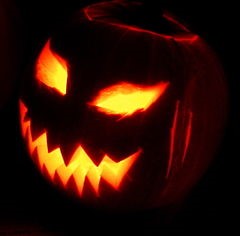HISTORY OF HALLOWEEN
Standing on the line
between fall and winter, plenty and paucity, life and death, Halloween is a
time of celebration and superstition. It is thought to have originated with the
ancient Celtic festival of Samhain, when people would light bonfires and wear
costumes to ward off roaming ghosts. The Celts, who lived 2,000 years ago in
the area that is now Ireland, the United Kingdom and northern France,
celebrated their new year on November 1.This day marked the end of summer and the
harvest and the beginning of the dark, cold winter, a time of year that was
often associated with human death. Celts
believed that on the night before the New Year, the ghosts of the dead returned
to earth.
In the eighth century,
Pope Gregory III designated November 1 as a time to honor all saints and
martyrs; the holiday, All Saints’ Day, incorporated some of the traditions of
Samhain. The evening before was known as All Hallows’ Eve and later Halloween. Over time, Halloween evolved into
community-based event characterized by child-friendly activities such as
trick-or-treating.
HALLOWEEN
COMES TO AMERICA
Celebration of Halloween
was extremely limited in colonial New England because of the rigid Protestant
belief systems there. Halloween was much more common in Maryland and the southern colonies. As the beliefs and
customs of different European ethnic groups as well as the American Indians
meshed, a distinctly American version of Halloween began to emerge. The first
celebrations included “play parties,” public events held to celebrate the
harvest, where neighbors would share stories of the dead, tell each other’s
fortunes, dance and sing. In the late 1800s, there was a move in America to
mold Halloween into a holiday more about community and neighborly get-togethers
than about ghosts, pranks and witchcraft.
TODAY’S HALLOWEEN
TRADITIONS
The American Halloween
tradition of “trick-or-treating” probably dates back to the early All Souls’
Day parades in England. During the festivities, poor citizens would beg for
food and families would give them pastries called “soul cakes” in return for
their promise to pray for the family’s dead relatives.
The
tradition of dressing in costume for Halloween has both European and Celtic
roots. Hundreds of years ago, winter was an uncertain and frightening time.
Food supplies often ran low and, for the many people afraid of the dark, the
short days of winter were full of constant worry. On Halloween, when it was
believed that ghosts came back to the earthly world, people thought that they
would encounter ghosts if they left their homes. To avoid being recognized by
these ghosts, people would wear masks when they left their homes after dark so
that the ghosts would mistake them for fellow spirits.
HALLOWEEN
SUPERSTITIONS
Halloween has always been a
holiday filled with mystery, magic and superstition. Today’s
Halloween ghosts are often depicted as more fearsome and malevolent, and our
customs and superstitions are scarier too. We avoid crossing paths with black
cats, afraid that they might bring us bad luck. We try not to walk under
ladders for the same reason. This superstition may have come from the ancient
Egyptians, who believed that triangles were sacred. And around Halloween,
especially, we try to avoid breaking mirrors, stepping on cracks in the road or
spilling salt.













.jpg)